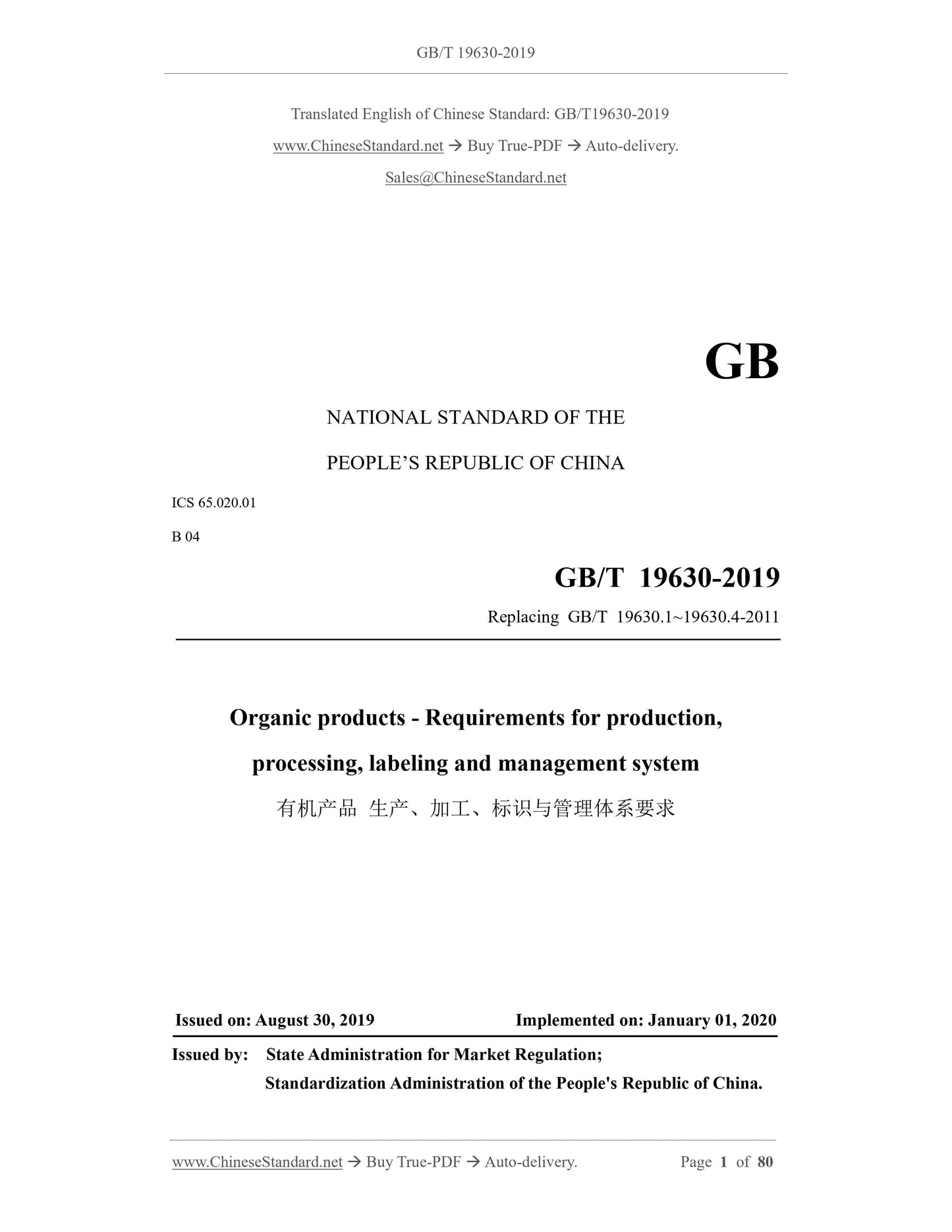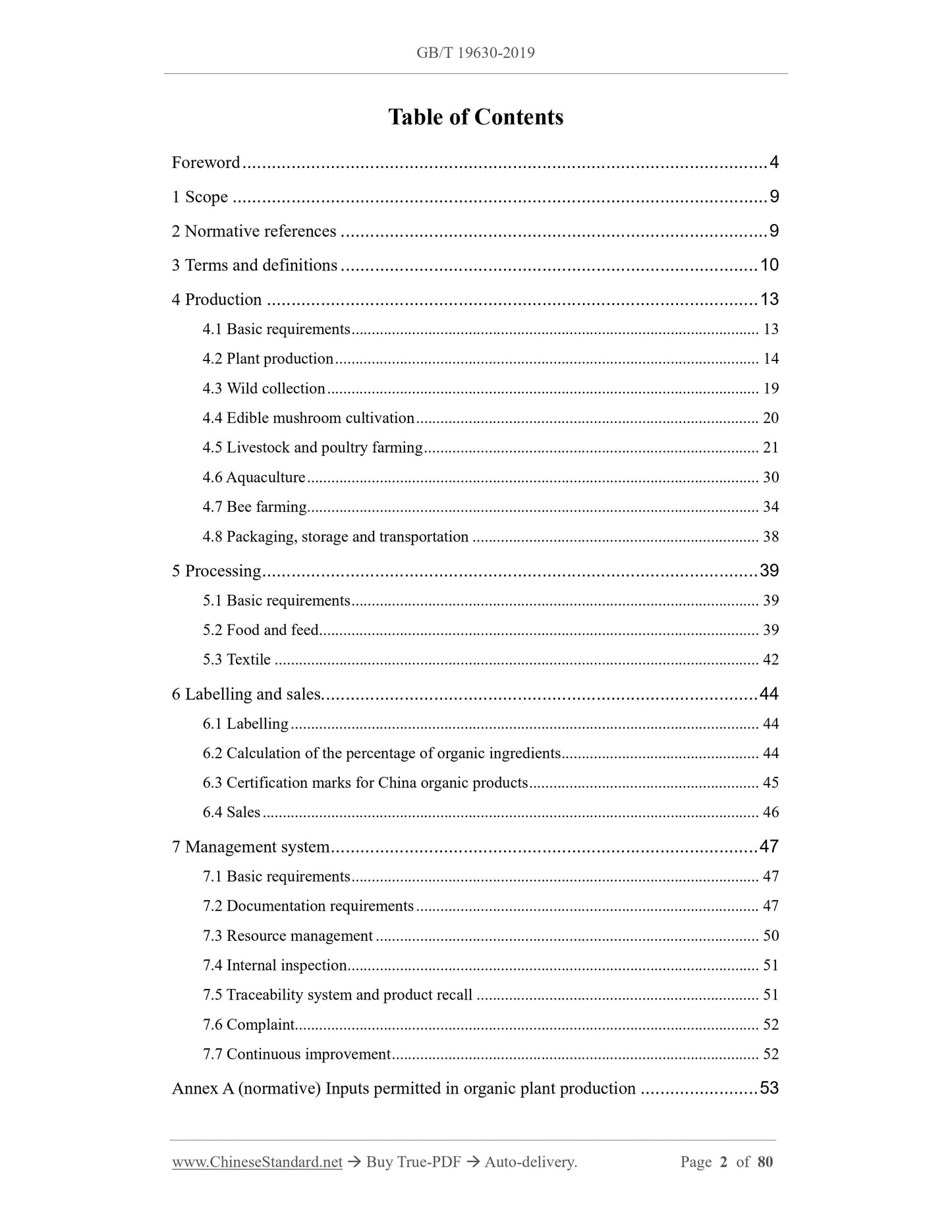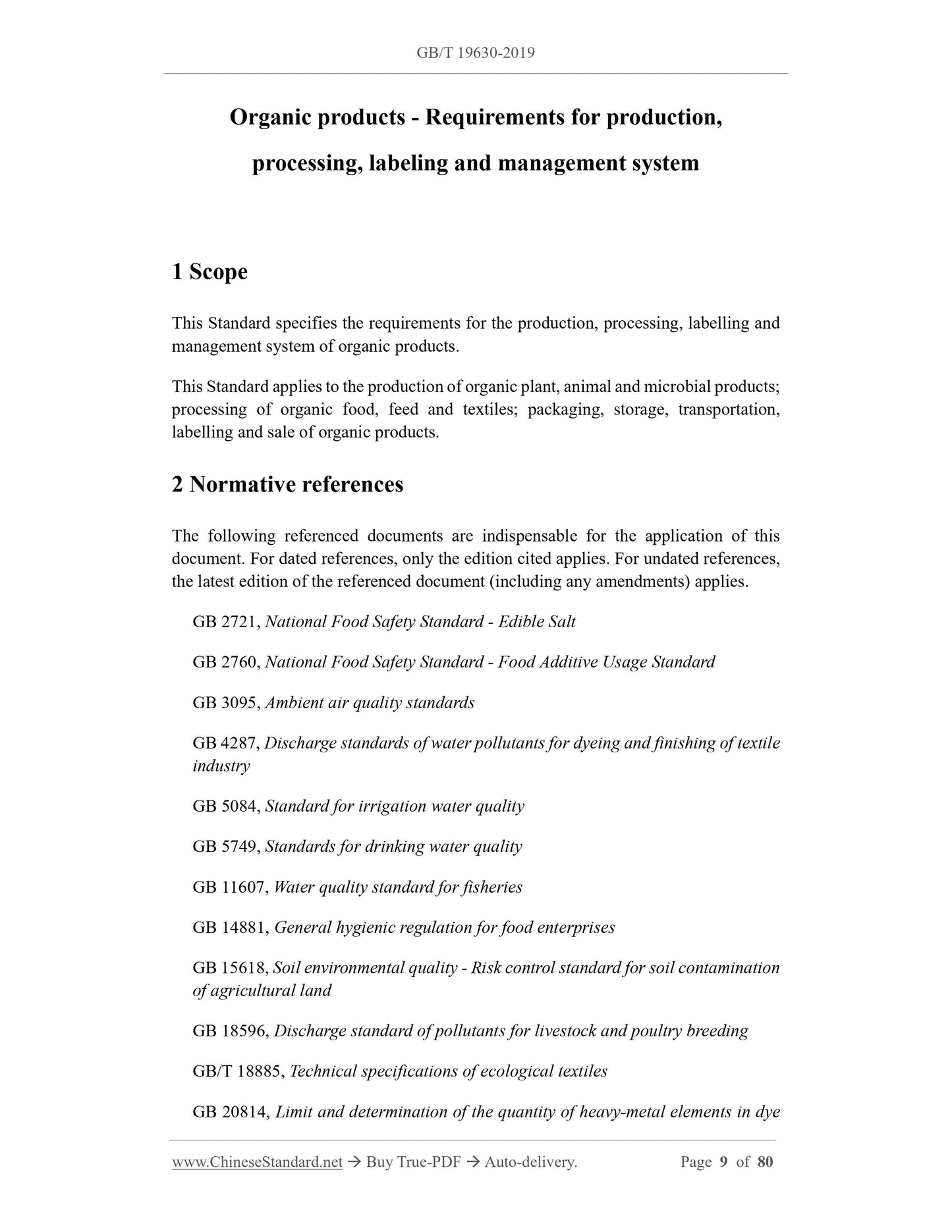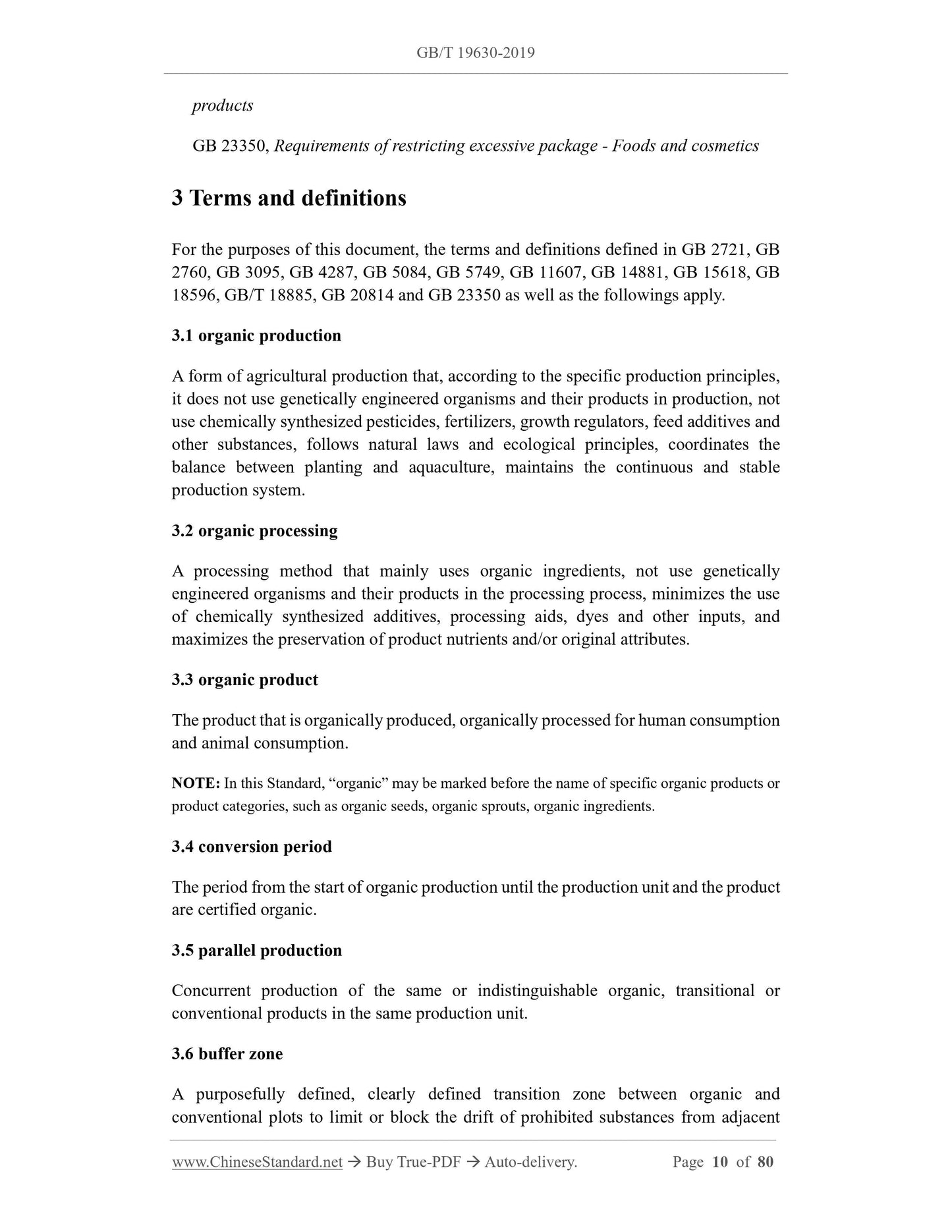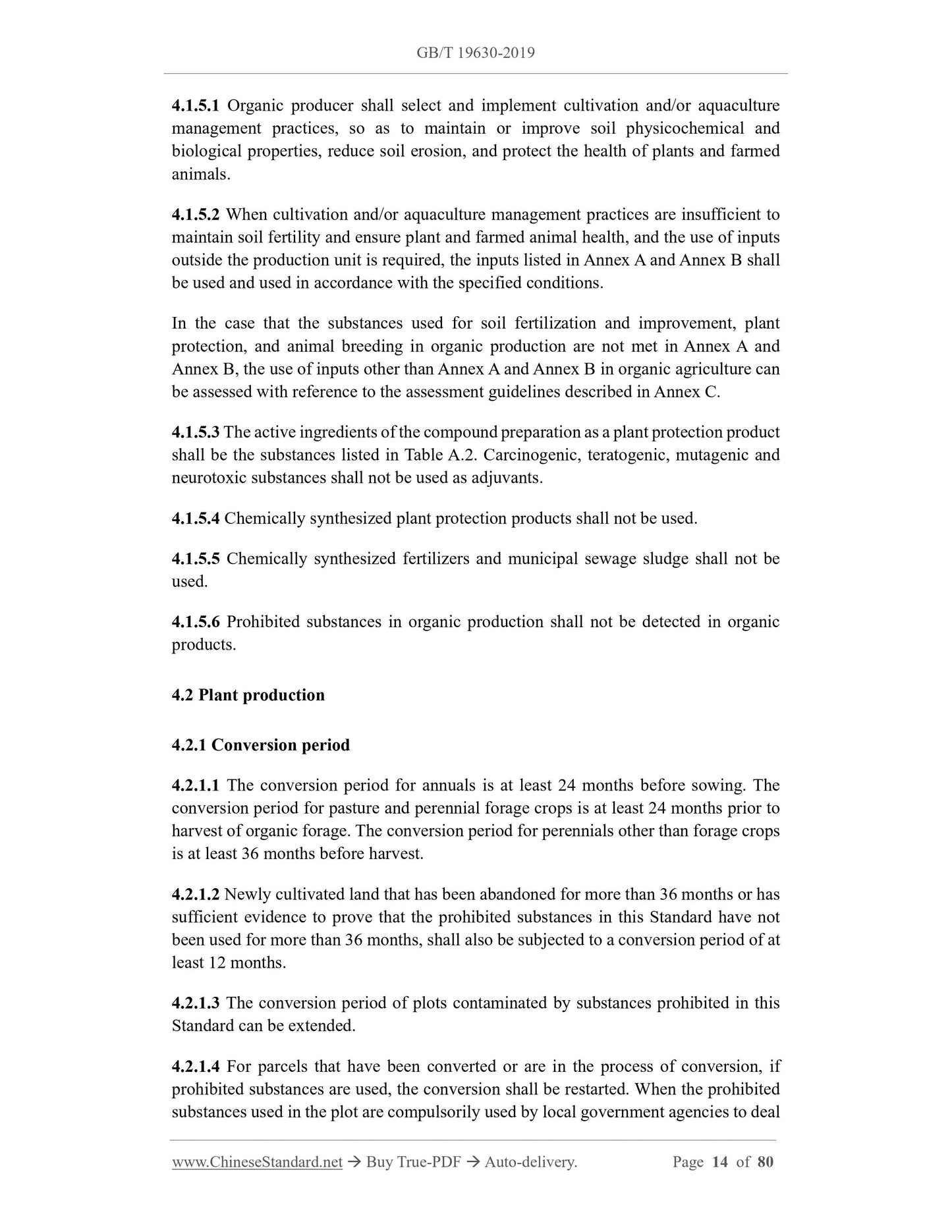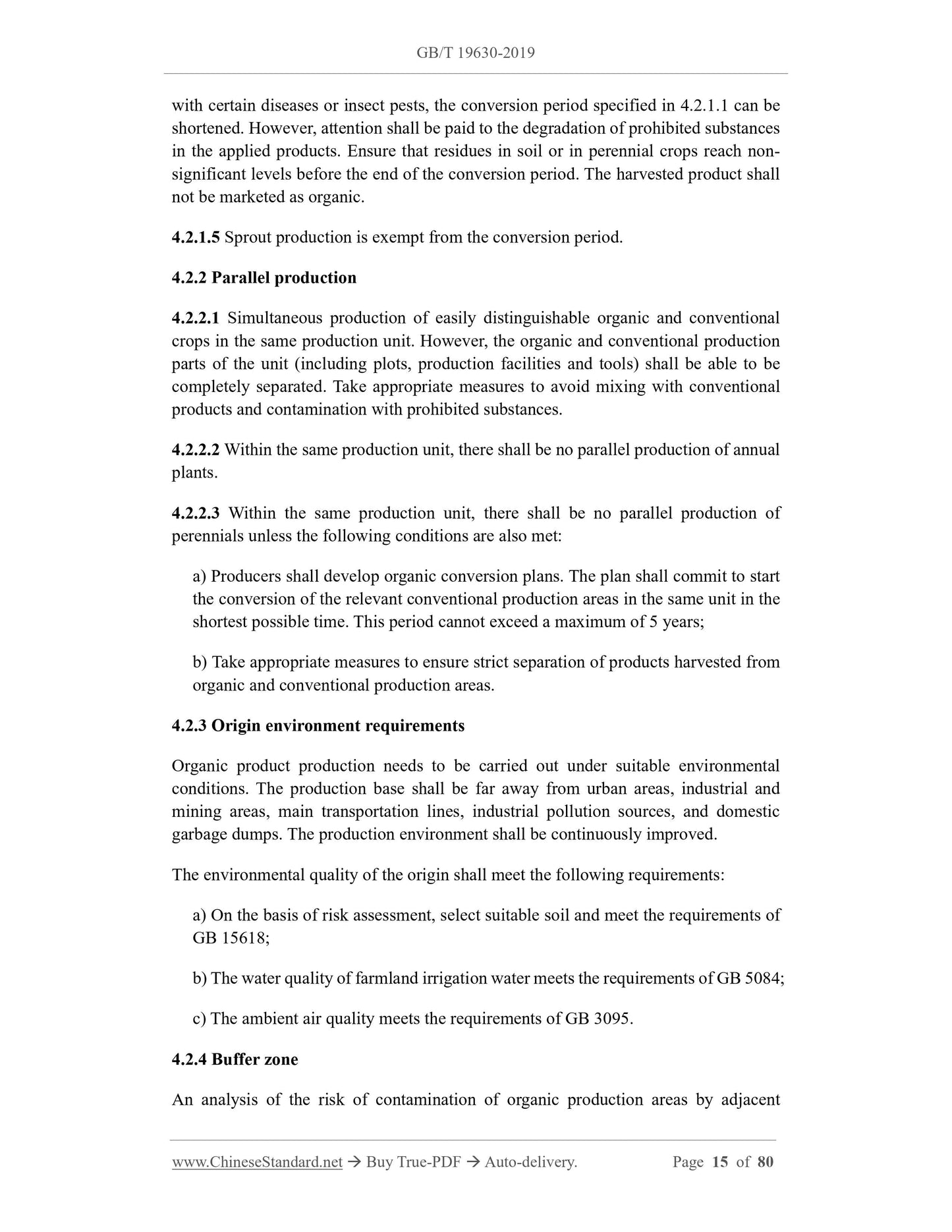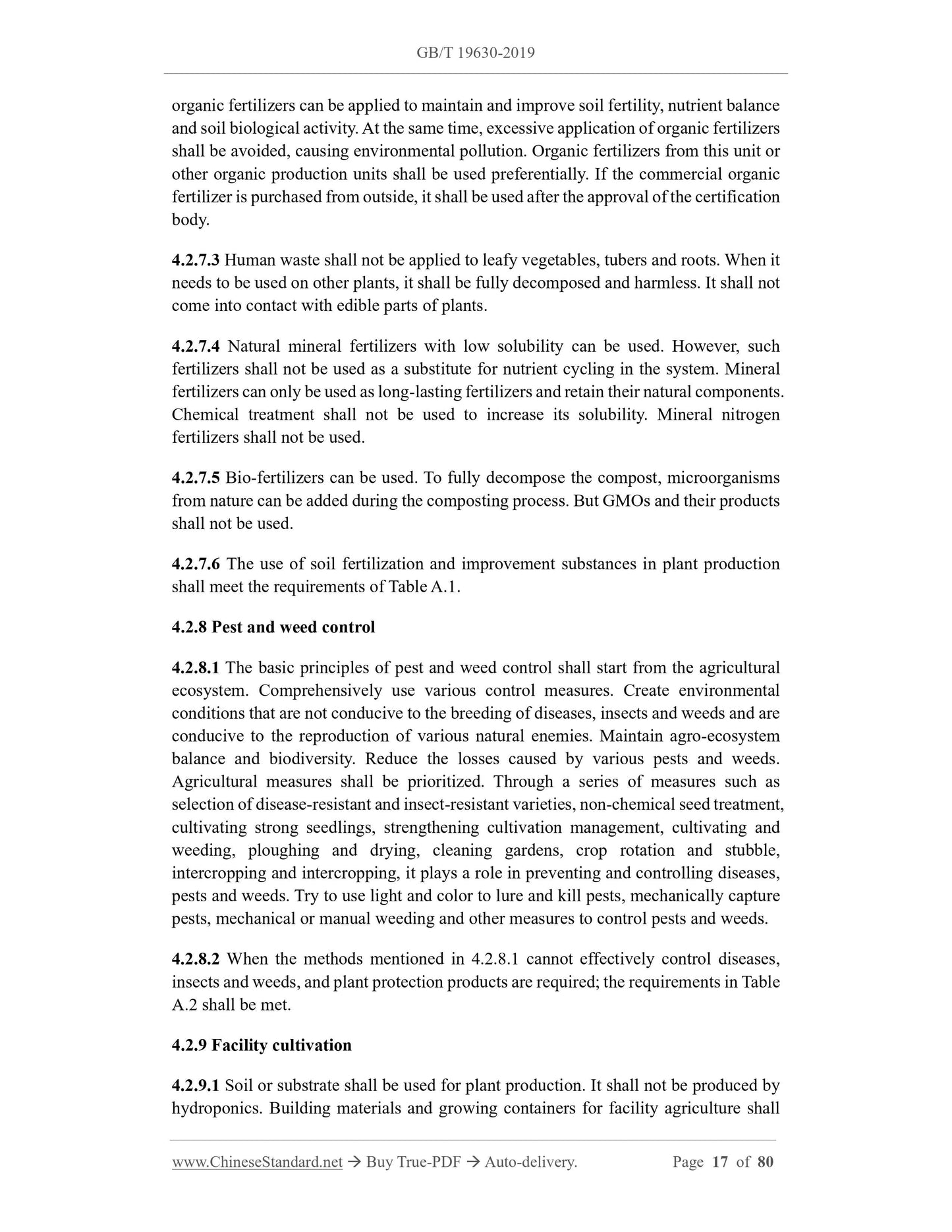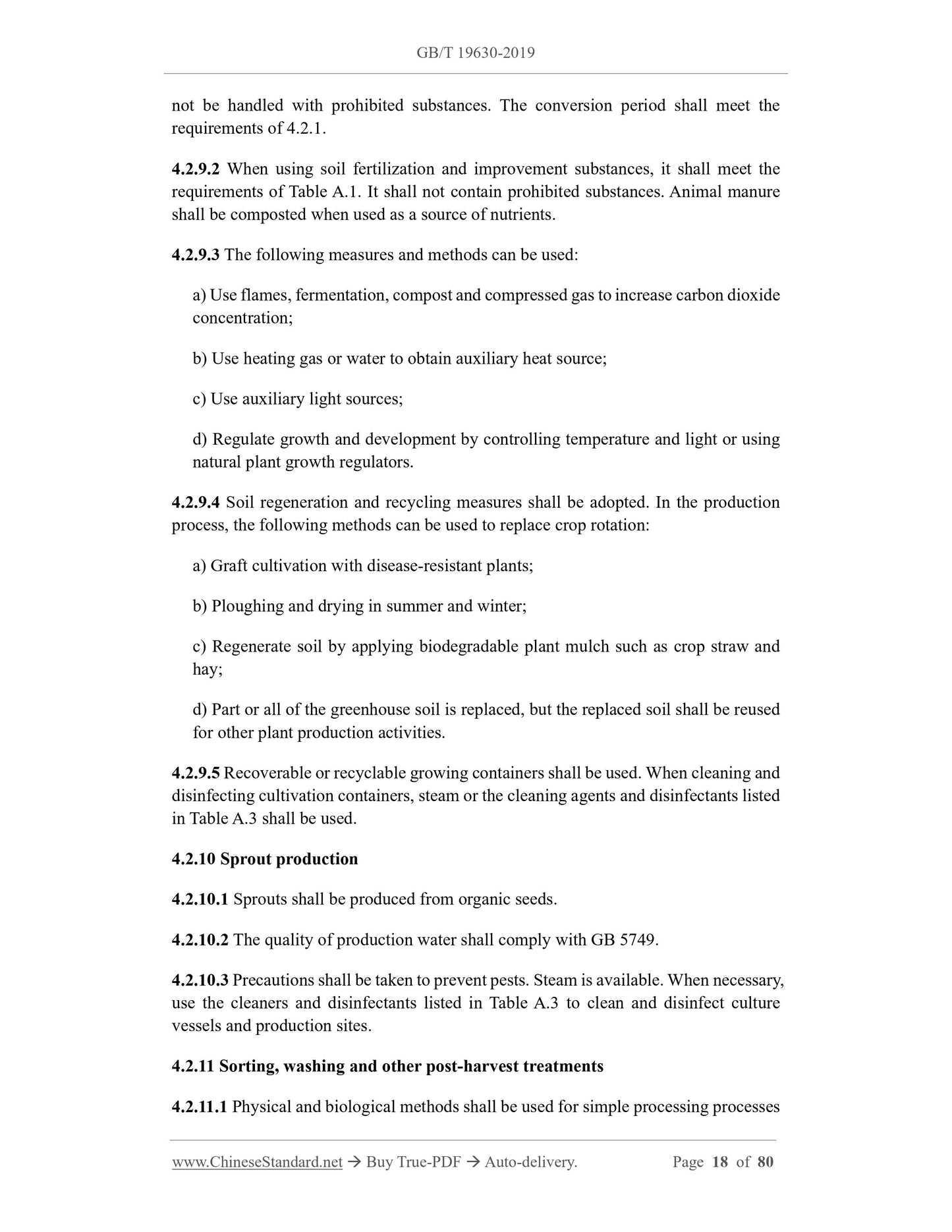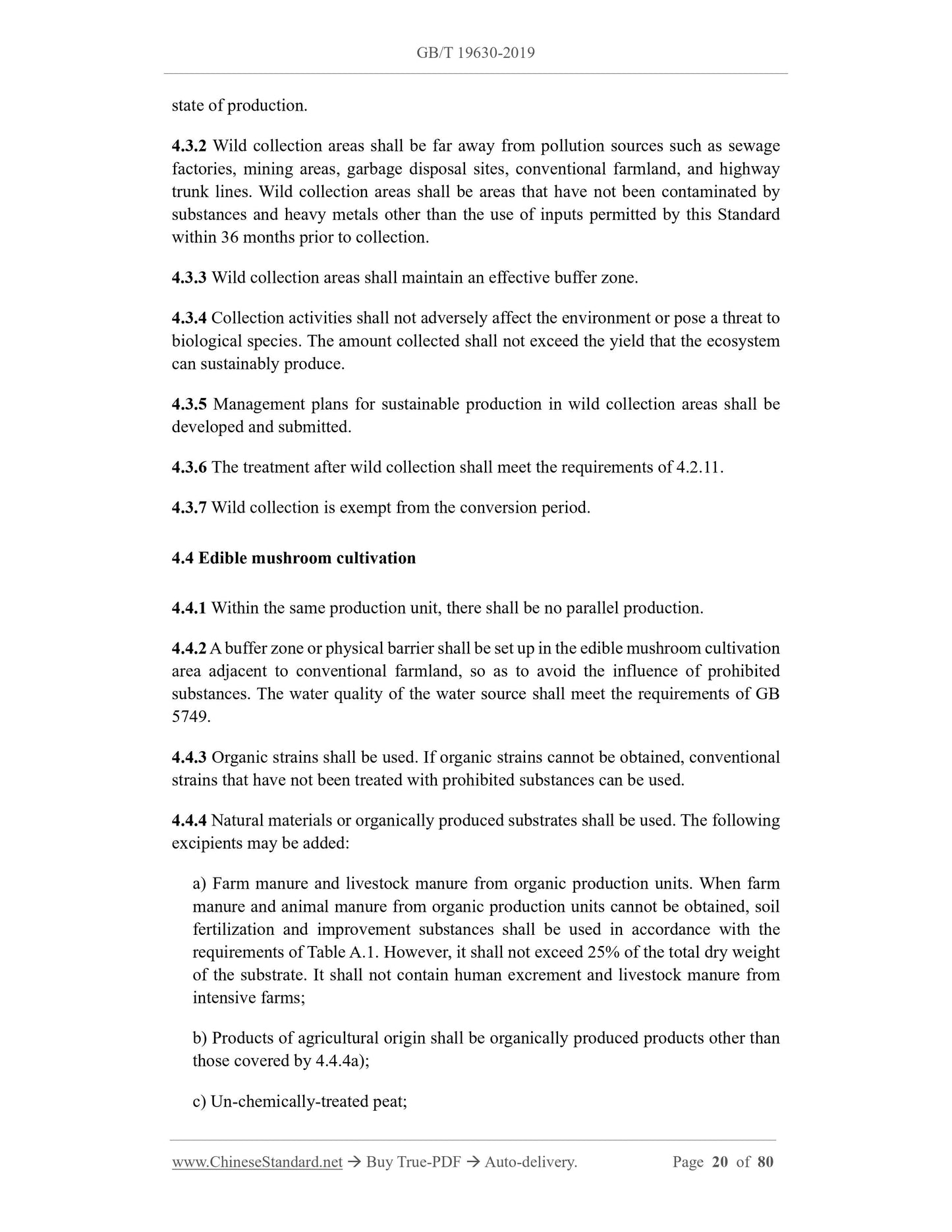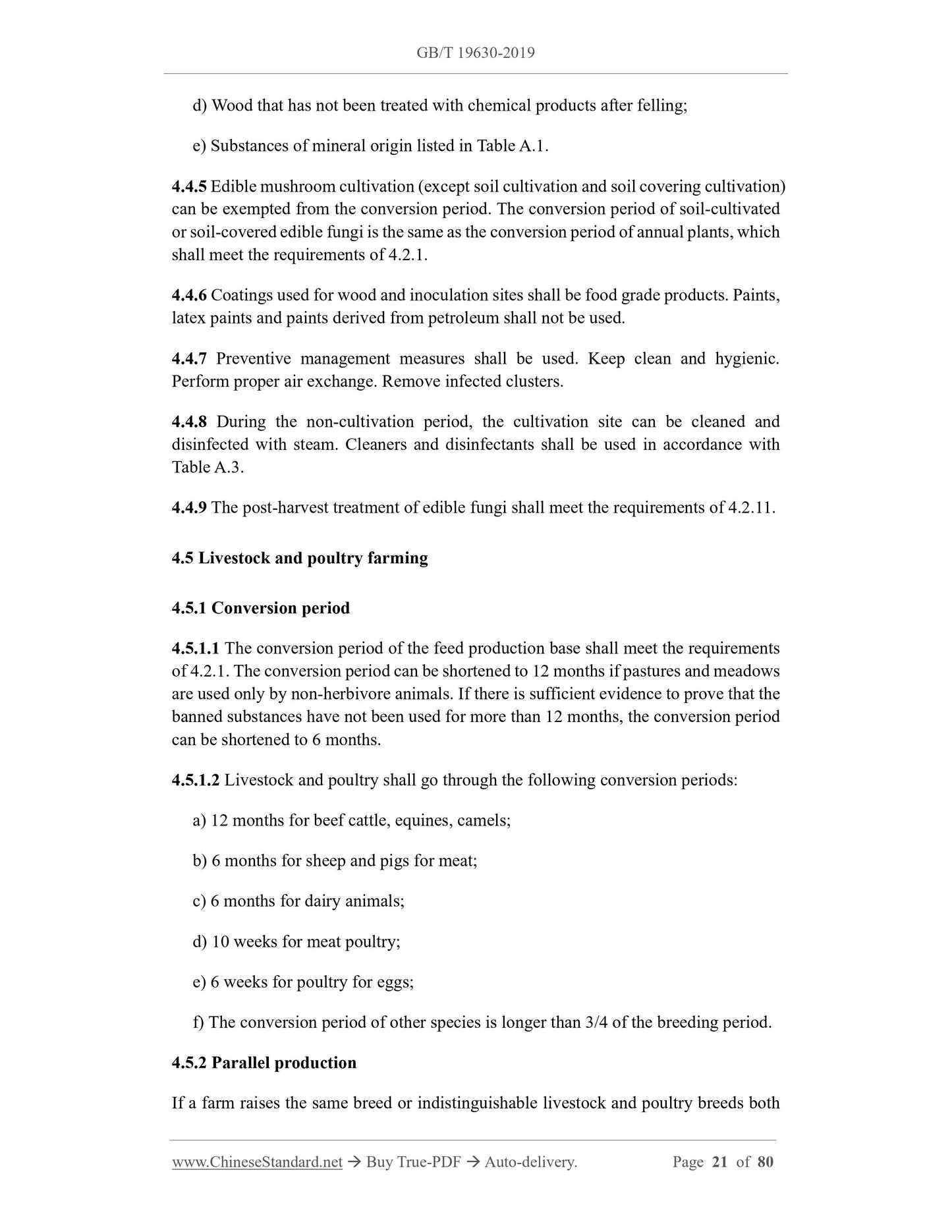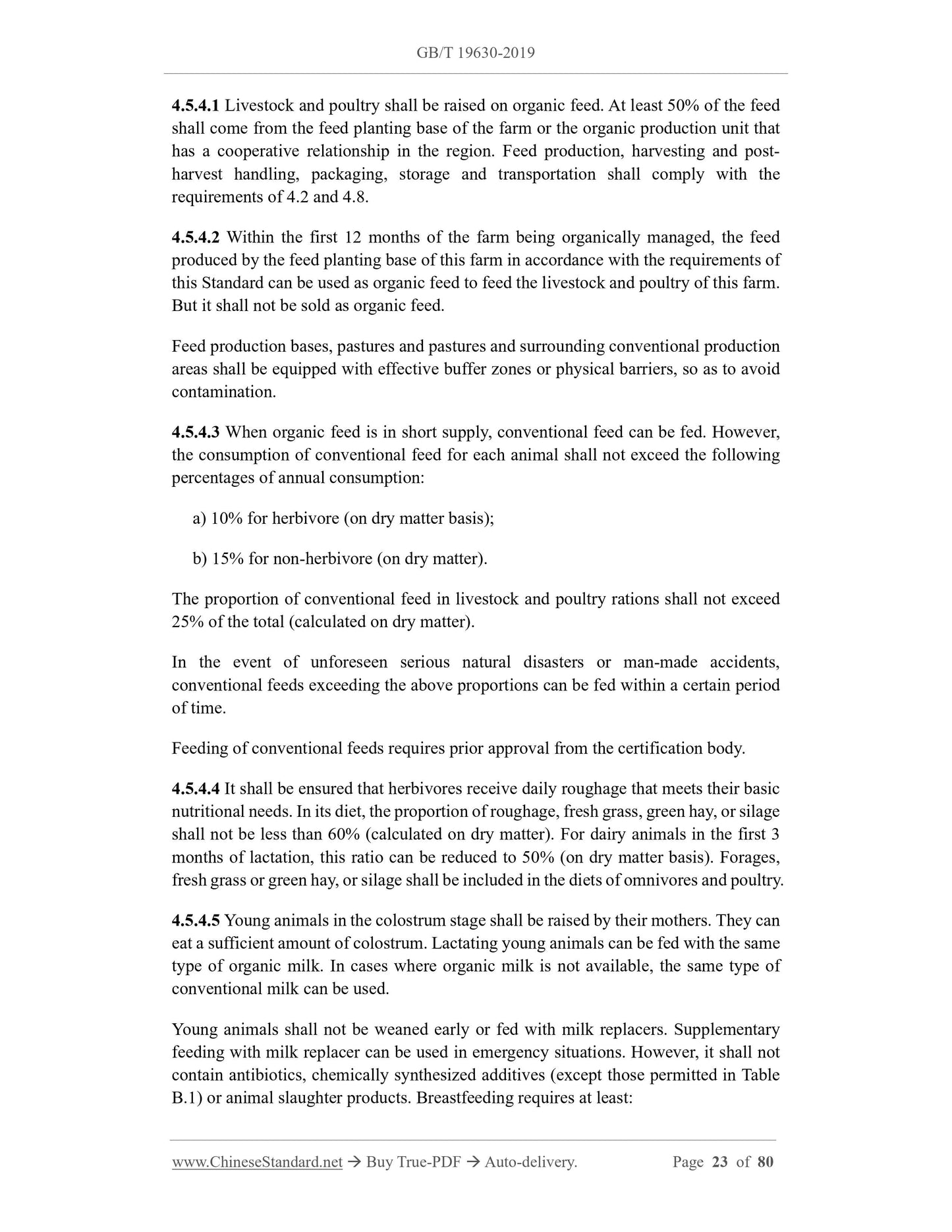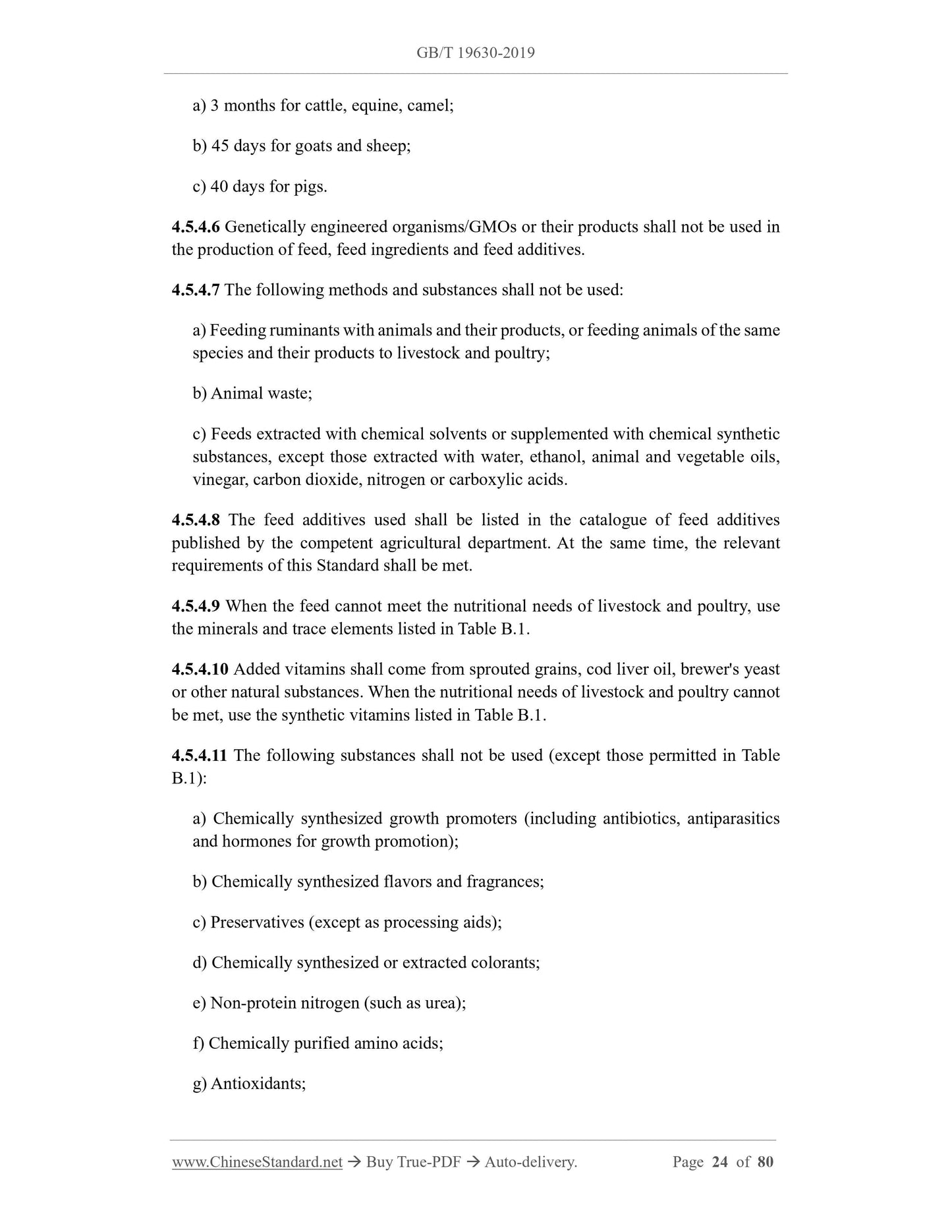1
/
of
12
www.ChineseStandard.us -- Field Test Asia Pte. Ltd.
GB/T 19630-2019 English PDF (GB/T19630-2019)
GB/T 19630-2019 English PDF (GB/T19630-2019)
Regular price
$505.00
Regular price
Sale price
$505.00
Unit price
/
per
Shipping calculated at checkout.
Couldn't load pickup availability
GB/T 19630-2019: Organic products - Requirements for production, processing, labeling and management system
Delivery: 9 seconds. Download (& Email) true-PDF + Invoice.
Get Quotation: Click GB/T 19630-2019 (Self-service in 1-minute)
Historical versions (Master-website): GB/T 19630-2019
Preview True-PDF (Reload/Scroll-down if blank)
GB/T 19630-2019
GB
NATIONAL STANDARD OF THE
PEOPLE’S REPUBLIC OF CHINA
ICS 65.020.01
B 04
Replacing GB/T 19630.1~19630.4-2011
Organic products - Requirements for production,
processing, labeling and management system
ISSUED ON: AUGUST 30, 2019
IMPLEMENTED ON: JANUARY 01, 2020
Issued by: State Administration for Market Regulation;
Standardization Administration of the People's Republic of China.
Table of Contents
Foreword ... 4
1 Scope ... 9
2 Normative references ... 9
3 Terms and definitions ... 10
4 Production ... 13
4.1 Basic requirements ... 13
4.2 Plant production ... 14
4.3 Wild collection ... 19
4.4 Edible mushroom cultivation ... 20
4.5 Livestock and poultry farming ... 21
4.6 Aquaculture ... 30
4.7 Bee farming ... 34
4.8 Packaging, storage and transportation ... 38
5 Processing ... 39
5.1 Basic requirements ... 39
5.2 Food and feed ... 39
5.3 Textile ... 42
6 Labelling and sales... 44
6.1 Labelling ... 44
6.2 Calculation of the percentage of organic ingredients ... 44
6.3 Certification marks for China organic products ... 45
6.4 Sales ... 46
7 Management system ... 47
7.1 Basic requirements ... 47
7.2 Documentation requirements ... 47
7.3 Resource management ... 50
7.4 Internal inspection ... 51
7.5 Traceability system and product recall ... 51
7.6 Complaint ... 52
7.7 Continuous improvement ... 52
Annex A (normative) Inputs permitted in organic plant production ... 53
Organic products - Requirements for production,
processing, labeling and management system
1 Scope
This Standard specifies the requirements for the production, processing, labelling and
management system of organic products.
This Standard applies to the production of organic plant, animal and microbial products;
processing of organic food, feed and textiles; packaging, storage, transportation,
labelling and sale of organic products.
2 Normative references
The following referenced documents are indispensable for the application of this
document. For dated references, only the edition cited applies. For undated references,
the latest edition of the referenced document (including any amendments) applies.
GB 2721, National Food Safety Standard - Edible Salt
GB 2760, National Food Safety Standard - Food Additive Usage Standard
GB 3095, Ambient air quality standards
GB 4287, Discharge standards of water pollutants for dyeing and finishing of textile
industry
GB 5084, Standard for irrigation water quality
GB 5749, Standards for drinking water quality
GB 11607, Water quality standard for fisheries
GB 14881, General hygienic regulation for food enterprises
GB 15618, Soil environmental quality - Risk control standard for soil contamination
of agricultural land
GB 18596, Discharge standard of pollutants for livestock and poultry breeding
GB/T 18885, Technical specifications of ecological textiles
GB 20814, Limit and determination of the quantity of heavy-metal elements in dye
products
GB 23350, Requirements of restricting excessive package - Foods and cosmetics
3 Terms and definitions
For the purposes of this document, the terms and definitions defined in GB 2721, GB
2760, GB 3095, GB 4287, GB 5084, GB 5749, GB 11607, GB 14881, GB 15618, GB
18596, GB/T 18885, GB 20814 and GB 23350 as well as the followings apply.
3.1 organic production
A form of agricultural production that, according to the specific production principles,
it does not use genetically engineered organisms and their products in production, not
use chemically synthesized pesticides, fertilizers, growth regulators, feed additives and
other substances, follows natural laws and ecological principles, coordinates the
balance between planting and aquaculture, maintains the continuous and stable
production system.
3.2 organic processing
A processing method that mainly uses organic ingredients, not use genetically
engineered organisms and their products in the processing process, minimizes the use
of chemically synthesized additives, processing aids, dyes and other inputs, and
maximizes the preservation of product nutrients and/or original attributes.
3.3 organic product
The product that is organically produced, organically processed for human consumption
and animal consumption.
NOTE: In this Standard, “organic” may be marked before the name of specific organic products or
product categories, such as organic seeds, organic sprouts, organic ingredients.
3.4 conversion period
The period from the start of organic production until the production unit and the product
are certified organic.
3.5 parallel production
Concurrent production of the same or indistinguishable organic, transitional or
conventional products in the same production unit.
3.6 buffer zone
A purposefully defined, clearly defined transition zone between organic and
conventional plots to limit or block the drift of prohibited substances from adjacent
4.1.5.1 Organic producer shall select and implement cultivation and/or aquaculture
management practices, so as to maintain or improve soil physicochemical and
biological properties, reduce soil erosion, and protect the health of plants and farmed
animals.
4.1.5.2 When cultivation and/or aquaculture management practices are insufficient to
maintain soil fertility and ensure plant and farmed animal health, and the use of inputs
outside the production unit is required, the inputs listed in Annex A and Annex B shall
be used and used in accordance with the specified conditions.
In the case that the substances used for soil fertilization and improvement, plant
protection, and animal breeding in organic production are not met in Annex A and
Annex B, the use of inputs other than Annex A and Annex B in organic agriculture can
be assessed with reference to the assessment guidelines described in Annex C.
4.1.5.3 The active ingredients of the compound preparation as a plant protection product
shall be the substances listed in Table A.2. Carcinogenic, teratogenic, mutagenic and
neurotoxic substances shall not be used as adjuvants.
4.1.5.4 Chemically synthesized plant protection products shall not be used.
4.1.5.5 Chemically synthesized fertilizers and municipal sewage sludge shall not be
used.
4.1.5.6 Prohibited substances in organic production shall not be detected in organic
products.
4.2 Plant production
4.2.1 Conversion period
4.2.1.1 The conversion period for annuals is at least 24 months before sowing. The
conversion period for pasture and perennial forage crops is at least 24 months prior to
harvest of organic forage. The conversion period for perennials other than forage crops
is at least 36 months before harvest.
4.2.1.2 Newly cultivated land that has been abandoned for more than 36 months or has
sufficient evidence to prove that the prohibited substances in this Standard have not
been used for more than 36 months, shall also be subjected to a conversion period of at
least 12 months.
4.2.1.3 The conversion period of plots contaminated by substances prohibited in this
Standard can be extended.
4.2.1.4 For parcels that have been converted or are in the process of conversion, if
prohibited substances are used, the conversion shall be restarted. When the prohibited
substances used in the plot are compulsorily used by local government agencies to deal
with certain diseases or insect pests, the conversion period specified in 4.2.1.1 can be
shortened. However, attention shall be paid to the degradation of prohibited substances
in the applied products. Ensure that residues in soil or in perennial crops reach non-
significant levels before the end of the conversion period. The harvested product shall
not be marketed as organic.
4.2.1.5 Sprout production is exempt from the conversion period.
4.2.2 Parallel production
4.2.2.1 Simultaneous production of easily distinguishable organic and conventional
crops in the same production unit. However, the organic and conventional production
parts of the unit (including plots, production facilities and tools) shall be able to be
completely separated. Take appropriate measures to avoid mixing with conventional
products and contamination with prohibited substances.
4.2.2.2 Within the same production unit, there shall be no parallel production of annual
plants.
4.2.2.3 Within the same production unit, there shall be no parallel production of
perennials unless the following conditions are also met:
a) Producers shall develop organic conversion plans. The plan shall commit to start
the conversion of the relevant conventional production areas in the same unit in the
shortest possible time. This period cannot exceed a maximum of 5 years;
b) Take appropriate measures to ensure strict separation of products harvested from
organic and conventional production areas.
4.2.3 Origin environment requirements
Organic product production needs to be carried out under suitable environmental
conditions. The production base shall be far away from urban areas, industrial and
mining areas, main transportation lines, industrial pollution sources, and domestic
garbage dumps. The production environment shall be continuously improved.
The environmental quality of the origin shall meet the following requirements:
a) On the basis of risk assessment, select suitable soil and meet the requirements of
GB 15618;
b) The water quality of farmland irrigation water meets the requirements of GB 5084;
c) The ambient air quality meets the requirements of GB 3095.
4.2.4 Buffer zone
An analysis of the risk of contamination of organic production areas by adjacent
organic fertilizers can be applied to maintain and improve soil fertility, nutrient balance
and soil biological activity. At the same time, excessive application of organic fertilizers
shall be avoided, causing environmental pollution. Organic fertilizers from this unit or
other organic production units shall be used preferentially. If the commercial organic
fertilizer is purchased from outside, it shall be used after the approval of the certification
body.
4.2.7.3 Human waste shall not be applied to leafy vegetables, tubers and roots. When it
needs to be used on other plants, it shall be fully decomposed and harmless. It shall not
come into contact with edible parts of plants.
4.2.7.4 Natural mineral fertilizers with low solubility can be used. However, such
fertilizers shall not be used as a substitute for nutrient cycling in the system. Mineral
fertilizers can only be used as long-lasting fertilizers and retain their natural components.
Chemical treatment shall not be used to increase its solubility. Mineral nitrogen
fertilizers shall not be used.
4.2.7.5 Bio-fertilizers can be used. To fully decompose the compost, microorganisms
from nature can be added during the composting process. But GMOs and their products
shall not be used.
4.2.7.6 The use of soil fertilization and improvement substances in plant production
shall meet the requirements of Table A.1.
4.2.8 Pest and weed control
4.2.8.1 The basic principles of pest and weed control shall start from the agricultural
ecosystem. Comprehensively use various control measures. Create environmental
conditions that are not conducive to the breeding of diseases, insects and weeds and are
conducive to the reproduction of various natural enemies. Maintain agro-ecosystem
balance and biodiversity. Reduce the losses caused by various pests and weeds.
Agricultural measures shall be prioritized. Through a series of measures such as
selection of disease-resistant and insect-resistant varieties, non-chemical seed treatment,
cultivating strong seedlings, strengthening cultivation management, cultivating and
weeding, ploughing and drying, cleaning gardens, crop rotation and stubble,
intercropping and intercropping, it plays a role in preventing and controlling diseases,
pests and weeds. Try to use light and color to lure and kill pests, mechanically capture
pests, mechanical or manual weeding and other measures to control pests and weeds.
4.2.8.2 When the methods mentioned in 4.2.8.1 cannot effectively control diseases,
insects and weeds, and plant protection products are required; the requirements in Table
A.2 shall be met.
4.2.9 Facility cultivation
4.2.9.1 Soil or substrate shall be used for plant production. It shall not be produced by
hydroponics. Building materials and growing containers for facility agriculture shall
not be handled with prohibited substances. The conversion period shall meet the
requirements of 4.2.1.
4.2.9.2 When using soil fertilization and improvement substances, it shall meet the
requirements of Table A.1. It shall not contain prohibited substances. Animal manure
shall be composted when used as a source of nutrients.
4.2.9.3 The following measures and methods can be used:
a) Use flames, fermentation, compost and compressed gas to increase carbon dioxide
concentration;
b) Use heating gas or water to obtain auxiliary heat source;
c) Use auxiliary light sources;
d) Regulate growth and development by controlling temperature and light or using
natural plant growth regulators.
4.2.9.4 Soil regeneration and recycling measures shall be adopted. In the production
process, the following methods can be used to replace crop rotation:
a) Graft cultivation with disease-resistant plants;
b) Ploughing and drying in summer and winter;
c) Regenerate soil by applying biodegradable plant mulch such as crop straw and
hay;
d) Part or all of the greenhouse soil is replaced, but the replaced soil shall be reused
for other plant production activities.
4.2.9.5 Recoverable or recyclable growing containers shall be used. When cleaning and
disinfecting cultivation containers, steam or the cleaning agents and disinfectants listed
in Table A.3 shall be used.
4.2.10 Sprout production
4.2.10.1 Sprouts shall be produced from organic seeds.
4.2.10.2 The quality of production water shall comply with GB 5749.
4.2.10.3 Precautions sh...
Delivery: 9 seconds. Download (& Email) true-PDF + Invoice.
Get Quotation: Click GB/T 19630-2019 (Self-service in 1-minute)
Historical versions (Master-website): GB/T 19630-2019
Preview True-PDF (Reload/Scroll-down if blank)
GB/T 19630-2019
GB
NATIONAL STANDARD OF THE
PEOPLE’S REPUBLIC OF CHINA
ICS 65.020.01
B 04
Replacing GB/T 19630.1~19630.4-2011
Organic products - Requirements for production,
processing, labeling and management system
ISSUED ON: AUGUST 30, 2019
IMPLEMENTED ON: JANUARY 01, 2020
Issued by: State Administration for Market Regulation;
Standardization Administration of the People's Republic of China.
Table of Contents
Foreword ... 4
1 Scope ... 9
2 Normative references ... 9
3 Terms and definitions ... 10
4 Production ... 13
4.1 Basic requirements ... 13
4.2 Plant production ... 14
4.3 Wild collection ... 19
4.4 Edible mushroom cultivation ... 20
4.5 Livestock and poultry farming ... 21
4.6 Aquaculture ... 30
4.7 Bee farming ... 34
4.8 Packaging, storage and transportation ... 38
5 Processing ... 39
5.1 Basic requirements ... 39
5.2 Food and feed ... 39
5.3 Textile ... 42
6 Labelling and sales... 44
6.1 Labelling ... 44
6.2 Calculation of the percentage of organic ingredients ... 44
6.3 Certification marks for China organic products ... 45
6.4 Sales ... 46
7 Management system ... 47
7.1 Basic requirements ... 47
7.2 Documentation requirements ... 47
7.3 Resource management ... 50
7.4 Internal inspection ... 51
7.5 Traceability system and product recall ... 51
7.6 Complaint ... 52
7.7 Continuous improvement ... 52
Annex A (normative) Inputs permitted in organic plant production ... 53
Organic products - Requirements for production,
processing, labeling and management system
1 Scope
This Standard specifies the requirements for the production, processing, labelling and
management system of organic products.
This Standard applies to the production of organic plant, animal and microbial products;
processing of organic food, feed and textiles; packaging, storage, transportation,
labelling and sale of organic products.
2 Normative references
The following referenced documents are indispensable for the application of this
document. For dated references, only the edition cited applies. For undated references,
the latest edition of the referenced document (including any amendments) applies.
GB 2721, National Food Safety Standard - Edible Salt
GB 2760, National Food Safety Standard - Food Additive Usage Standard
GB 3095, Ambient air quality standards
GB 4287, Discharge standards of water pollutants for dyeing and finishing of textile
industry
GB 5084, Standard for irrigation water quality
GB 5749, Standards for drinking water quality
GB 11607, Water quality standard for fisheries
GB 14881, General hygienic regulation for food enterprises
GB 15618, Soil environmental quality - Risk control standard for soil contamination
of agricultural land
GB 18596, Discharge standard of pollutants for livestock and poultry breeding
GB/T 18885, Technical specifications of ecological textiles
GB 20814, Limit and determination of the quantity of heavy-metal elements in dye
products
GB 23350, Requirements of restricting excessive package - Foods and cosmetics
3 Terms and definitions
For the purposes of this document, the terms and definitions defined in GB 2721, GB
2760, GB 3095, GB 4287, GB 5084, GB 5749, GB 11607, GB 14881, GB 15618, GB
18596, GB/T 18885, GB 20814 and GB 23350 as well as the followings apply.
3.1 organic production
A form of agricultural production that, according to the specific production principles,
it does not use genetically engineered organisms and their products in production, not
use chemically synthesized pesticides, fertilizers, growth regulators, feed additives and
other substances, follows natural laws and ecological principles, coordinates the
balance between planting and aquaculture, maintains the continuous and stable
production system.
3.2 organic processing
A processing method that mainly uses organic ingredients, not use genetically
engineered organisms and their products in the processing process, minimizes the use
of chemically synthesized additives, processing aids, dyes and other inputs, and
maximizes the preservation of product nutrients and/or original attributes.
3.3 organic product
The product that is organically produced, organically processed for human consumption
and animal consumption.
NOTE: In this Standard, “organic” may be marked before the name of specific organic products or
product categories, such as organic seeds, organic sprouts, organic ingredients.
3.4 conversion period
The period from the start of organic production until the production unit and the product
are certified organic.
3.5 parallel production
Concurrent production of the same or indistinguishable organic, transitional or
conventional products in the same production unit.
3.6 buffer zone
A purposefully defined, clearly defined transition zone between organic and
conventional plots to limit or block the drift of prohibited substances from adjacent
4.1.5.1 Organic producer shall select and implement cultivation and/or aquaculture
management practices, so as to maintain or improve soil physicochemical and
biological properties, reduce soil erosion, and protect the health of plants and farmed
animals.
4.1.5.2 When cultivation and/or aquaculture management practices are insufficient to
maintain soil fertility and ensure plant and farmed animal health, and the use of inputs
outside the production unit is required, the inputs listed in Annex A and Annex B shall
be used and used in accordance with the specified conditions.
In the case that the substances used for soil fertilization and improvement, plant
protection, and animal breeding in organic production are not met in Annex A and
Annex B, the use of inputs other than Annex A and Annex B in organic agriculture can
be assessed with reference to the assessment guidelines described in Annex C.
4.1.5.3 The active ingredients of the compound preparation as a plant protection product
shall be the substances listed in Table A.2. Carcinogenic, teratogenic, mutagenic and
neurotoxic substances shall not be used as adjuvants.
4.1.5.4 Chemically synthesized plant protection products shall not be used.
4.1.5.5 Chemically synthesized fertilizers and municipal sewage sludge shall not be
used.
4.1.5.6 Prohibited substances in organic production shall not be detected in organic
products.
4.2 Plant production
4.2.1 Conversion period
4.2.1.1 The conversion period for annuals is at least 24 months before sowing. The
conversion period for pasture and perennial forage crops is at least 24 months prior to
harvest of organic forage. The conversion period for perennials other than forage crops
is at least 36 months before harvest.
4.2.1.2 Newly cultivated land that has been abandoned for more than 36 months or has
sufficient evidence to prove that the prohibited substances in this Standard have not
been used for more than 36 months, shall also be subjected to a conversion period of at
least 12 months.
4.2.1.3 The conversion period of plots contaminated by substances prohibited in this
Standard can be extended.
4.2.1.4 For parcels that have been converted or are in the process of conversion, if
prohibited substances are used, the conversion shall be restarted. When the prohibited
substances used in the plot are compulsorily used by local government agencies to deal
with certain diseases or insect pests, the conversion period specified in 4.2.1.1 can be
shortened. However, attention shall be paid to the degradation of prohibited substances
in the applied products. Ensure that residues in soil or in perennial crops reach non-
significant levels before the end of the conversion period. The harvested product shall
not be marketed as organic.
4.2.1.5 Sprout production is exempt from the conversion period.
4.2.2 Parallel production
4.2.2.1 Simultaneous production of easily distinguishable organic and conventional
crops in the same production unit. However, the organic and conventional production
parts of the unit (including plots, production facilities and tools) shall be able to be
completely separated. Take appropriate measures to avoid mixing with conventional
products and contamination with prohibited substances.
4.2.2.2 Within the same production unit, there shall be no parallel production of annual
plants.
4.2.2.3 Within the same production unit, there shall be no parallel production of
perennials unless the following conditions are also met:
a) Producers shall develop organic conversion plans. The plan shall commit to start
the conversion of the relevant conventional production areas in the same unit in the
shortest possible time. This period cannot exceed a maximum of 5 years;
b) Take appropriate measures to ensure strict separation of products harvested from
organic and conventional production areas.
4.2.3 Origin environment requirements
Organic product production needs to be carried out under suitable environmental
conditions. The production base shall be far away from urban areas, industrial and
mining areas, main transportation lines, industrial pollution sources, and domestic
garbage dumps. The production environment shall be continuously improved.
The environmental quality of the origin shall meet the following requirements:
a) On the basis of risk assessment, select suitable soil and meet the requirements of
GB 15618;
b) The water quality of farmland irrigation water meets the requirements of GB 5084;
c) The ambient air quality meets the requirements of GB 3095.
4.2.4 Buffer zone
An analysis of the risk of contamination of organic production areas by adjacent
organic fertilizers can be applied to maintain and improve soil fertility, nutrient balance
and soil biological activity. At the same time, excessive application of organic fertilizers
shall be avoided, causing environmental pollution. Organic fertilizers from this unit or
other organic production units shall be used preferentially. If the commercial organic
fertilizer is purchased from outside, it shall be used after the approval of the certification
body.
4.2.7.3 Human waste shall not be applied to leafy vegetables, tubers and roots. When it
needs to be used on other plants, it shall be fully decomposed and harmless. It shall not
come into contact with edible parts of plants.
4.2.7.4 Natural mineral fertilizers with low solubility can be used. However, such
fertilizers shall not be used as a substitute for nutrient cycling in the system. Mineral
fertilizers can only be used as long-lasting fertilizers and retain their natural components.
Chemical treatment shall not be used to increase its solubility. Mineral nitrogen
fertilizers shall not be used.
4.2.7.5 Bio-fertilizers can be used. To fully decompose the compost, microorganisms
from nature can be added during the composting process. But GMOs and their products
shall not be used.
4.2.7.6 The use of soil fertilization and improvement substances in plant production
shall meet the requirements of Table A.1.
4.2.8 Pest and weed control
4.2.8.1 The basic principles of pest and weed control shall start from the agricultural
ecosystem. Comprehensively use various control measures. Create environmental
conditions that are not conducive to the breeding of diseases, insects and weeds and are
conducive to the reproduction of various natural enemies. Maintain agro-ecosystem
balance and biodiversity. Reduce the losses caused by various pests and weeds.
Agricultural measures shall be prioritized. Through a series of measures such as
selection of disease-resistant and insect-resistant varieties, non-chemical seed treatment,
cultivating strong seedlings, strengthening cultivation management, cultivating and
weeding, ploughing and drying, cleaning gardens, crop rotation and stubble,
intercropping and intercropping, it plays a role in preventing and controlling diseases,
pests and weeds. Try to use light and color to lure and kill pests, mechanically capture
pests, mechanical or manual weeding and other measures to control pests and weeds.
4.2.8.2 When the methods mentioned in 4.2.8.1 cannot effectively control diseases,
insects and weeds, and plant protection products are required; the requirements in Table
A.2 shall be met.
4.2.9 Facility cultivation
4.2.9.1 Soil or substrate shall be used for plant production. It shall not be produced by
hydroponics. Building materials and growing containers for facility agriculture shall
not be handled with prohibited substances. The conversion period shall meet the
requirements of 4.2.1.
4.2.9.2 When using soil fertilization and improvement substances, it shall meet the
requirements of Table A.1. It shall not contain prohibited substances. Animal manure
shall be composted when used as a source of nutrients.
4.2.9.3 The following measures and methods can be used:
a) Use flames, fermentation, compost and compressed gas to increase carbon dioxide
concentration;
b) Use heating gas or water to obtain auxiliary heat source;
c) Use auxiliary light sources;
d) Regulate growth and development by controlling temperature and light or using
natural plant growth regulators.
4.2.9.4 Soil regeneration and recycling measures shall be adopted. In the production
process, the following methods can be used to replace crop rotation:
a) Graft cultivation with disease-resistant plants;
b) Ploughing and drying in summer and winter;
c) Regenerate soil by applying biodegradable plant mulch such as crop straw and
hay;
d) Part or all of the greenhouse soil is replaced, but the replaced soil shall be reused
for other plant production activities.
4.2.9.5 Recoverable or recyclable growing containers shall be used. When cleaning and
disinfecting cultivation containers, steam or the cleaning agents and disinfectants listed
in Table A.3 shall be used.
4.2.10 Sprout production
4.2.10.1 Sprouts shall be produced from organic seeds.
4.2.10.2 The quality of production water shall comply with GB 5749.
4.2.10.3 Precautions sh...
Share
